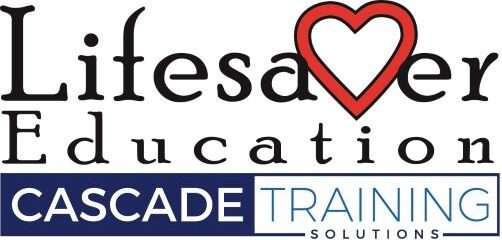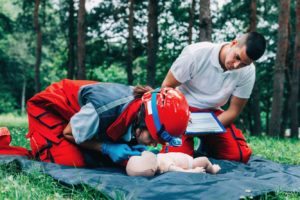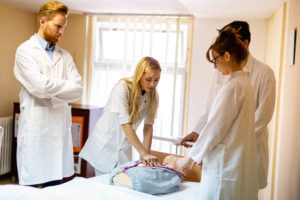On June 21, 2022 Guy Knickerbocker, “Father” of CPR, passed away at 89 years old in Narvon, PA. As a doctoral student studying electrical engineering at Johns Hopkins University, Knickerbocker developed cardiopulmonary resuscitation (CPR) with fellow electrical engineer William Kouwenhoven, PhD, and James Jude, M.D., cardiac surgeon and resident at The Johns Hopkins Hospital at the time. Going even further, the trio developed the prototype to the first portable external defibrillator in 1957, a predecessor to the automatic external defibrillator (AED) that can be found in nearly every business and public institution across the country.
Research and Contributions
In 1958, Knickerbocker discovered that pressure on the chest during defibrillation experiments in animals produced an arterial waveform and a temporary rise in blood pressure. This observation paved the way toward a new technique, which is now known as CPR. As a “Father” and originator of CPR, there is no question that Knickerbocker’s contributions to medicine have saved countless lives over the last six-plus decades.
In 1960, the trio of Knickerbocker, Kouwnhoven, and Jude published their breakthrough in research in the Journal of the American Medical Association. This breakthrough was the value of external cardiac massage in providing blood flow to vital organs for people in cardiac arrest. The trio notably stated in this landmark paper that, “Anyone, anywhere, can now initiate cardiac resuscitative procedures”, and that, “All that is needed are two hands”. Through the development of the prototype of the first portable defibrillator to this groundbreaking paper, this brilliant trio came to be regarded as the omit comma “fathers of CPR”.
As a “father” and Pioneer of CPR, it comes as no surprise that Knickerbocker spread awareness and helped develop many precursors to the knowledge of CPR and even CPR training. In addition to publishing over thirty papers on the topic of electricity and the human body, he also helped produce the 1960’s training film, “Pulse of Life”, which has been viewed by millions and helped popularize the use of CPR. These early and vital contributions laid the groundwork for classroom training such as BLS , PALS, and ACLS, to name a few.
Some notable achievements in Knickerbocker’s life include:
- Doctoral Graduate from Johns Hopkins University in Electrical Engineering
- Development of the first portable external defibrillator prototype.
- Development of cardiopulmonary resuscitation (CPR).
- Publication of over 30 papers on electricity and the human body.
- Collaborated with others to produce the influential CPR training film titled “Pulse of Life”.
In 1985, William Montgomery, MD, FAHA, first met Knickerbocker at an American Heart Association (AHA) conference on CPR and Emergency Cardiovascular Care (ECC). At that conference, Knickerbocker was honored by the AHA for his landmark contributions to CPR and ECC. Montgomery, currently serving as coordinator for the International Liaison Committee on Resuscitation (ILCOR), reinforced Knickerbocker’s immense contributions to the field and his status as a “Giant” in resuscitation science, saying that he will always be remembered for his crucial work in the laboratory and in training activities.
Some areas of resuscitation science not possible without Knickerbocker’s contributions:
- CPR – Cardiopulmonary Resuscitation
- AED – Automated External Defibrillator
- BLS – A comprehensive CPR class covering adults, infants and children for CPR, AED, and choking.
- PALS – An advanced class designed to teach students how to respond to a pediatric emergency, including infants and children with respiratory arrest, shock, abnormal heart rhythms, and cardiac arrest.
- ACLS – An advanced class designed to teach students how to respond to adults with abnormal heart rhythms, cardiac arrest, cardiac-related respiratory arrest, and stroke.
More Than A Researcher
Even in the later years of Knickerbocker’s life he was active within the CPR and ECC community. Knickerbocker and his wife, Joan, attended the citizen CPR Foundation’s Emergency Cardiac Care Conference (ECCU), where he met with survivors who were saved due to his research and contributions to resuscitation science. At these conferences, Montgomery recalled that, “Those survivors were so happy to meet with him in person and individually and take pictures “with the man who invented the technique that saved their lives. These were very warm and emotional meetings and Guy was always very gracious with everyone.”
In addition to his invaluable contributions to medical work, Knickerbocker’s impact on people as a person and not just as a scientist is a theme worth highlighting. Take the testimony of Dianne Atkins, MD, AHA ECC Committee Chair, who met Knickerbocker at ECCU events. Regarding his character and temperament, Atkins said that, “He was always a very pleasant man and willing to have his picture taken with everyone who asked,” and that, “ “He seemed quite humble about his accomplishments with respect to CPR, but also was quietly proud of them.”
Underlining the importance of Knickerbocker’s contribution and the practice of cardiopulmonary resuscitation, Atkins says that today it is known that immediate CPR, usually delivered by a lay rescuer, is a primary determinant of survival with good functional outcome. However, less than 50% of patients in cardiac arrest in the U.S. receive CPR before EMS arrives at the scene.
Additionally, according to Atkins, “The AHA and the ECC need to commit to better understanding how to engage the lay public in understanding the need for CPR, improve the percentage of those who receive lay rescuer CPR and to ensure that our teaching methods are the most effective for providing high-quality CPR.”
According to Comilla Sasson, MD, vice president of ECC Science and Innovation at AHA, Knickerbocker and his team of researchers fundamentally changed how cardiac arrest patients are treated. Continuing and building upon Knickerbocker’s esteemed legacy, the AHA is committed to providing CPR training to everyone. Supporting this, Sasson states that, “The American Heart Association is dedicated to making sure every person knows how to perform CPR, and can help save a life…and that all people, regardless of where they live or what healthcare system they are treated in, will have an equitable chance for surviving a cardiac arrest event.”
A Continued Legacy
There are other ways to ensure that Knickerbocker’s legacy can endure. One such way is for the AHA and ILCOR to continue supporting innovative research in the field of resuscitation science, says Rober Neumar, MD, Co-Chair of ILCOR. He states that, “We need to advocate for greater investment in resuscitation science and expand the pipeline of young scientists entering the field.” Not only will this lead to a continued and enduring legacy, but it will also honor Knickerbocker’s life’s work through the very innovative research conducted by him throughout his career.
There is no doubt that we are all saddened by the passing of such an incredible and influential person and vital contributor to the medical world. However, his legacy will forever live on and continue to touch countless people throughout the world.Montgomery said Knickerbocker will always be remembered as being one of the original scientists and investigators that discovered modern CPR as we know it today. Montgomery underlines this, saying that, “Even though he has passed, he will always live in the hearts and minds of all providers of CPR and survivors as a ‘Giant’ in resuscitation and the person responsible for discovering the technique that ‘saved my life.” Montgomery is not alone in having been saved by the very research and innovations made by Knickerbocker. There is no doubt that through organizations such as the American Heart Association, continued use of the AED, and further innovations in training like PALS and ACLS that Knickerbocker will continue to impact the hearts and lives of others.







